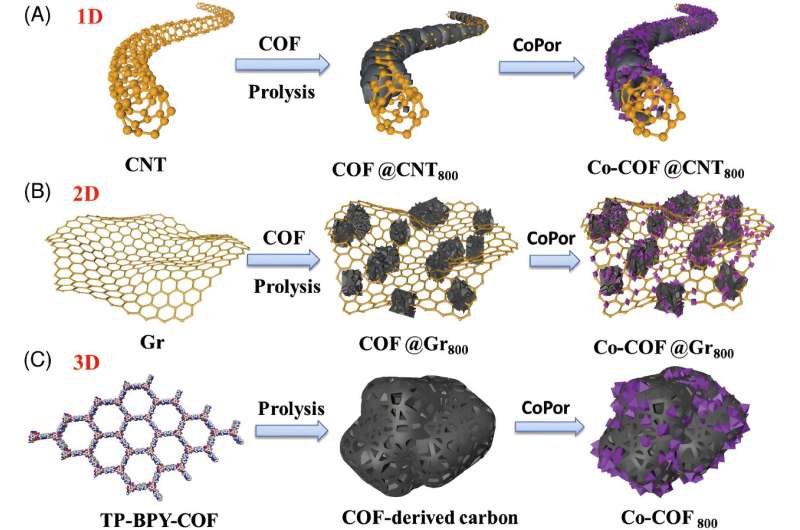This article has been reviewed according to Science X's editorial process and policies. Editors have highlighted the following attributes while ensuring the content's credibility:
fact-checked
trusted source
proofread
A novel approach for dimensional engineering of covalent organic frameworks derived carbons

Covalent organic frameworks (COFs) are a special class of materials composed of interconnected organic building blocks held together by strong chemical bonds. Featured with evenly distributed atoms and abundant internal empty space, COFs can be utilized as the starting point for developing functional carbon-based materials.
When they are subjected to high temperatures, COFs lose their two-dimensional (2D) flat shape and become a three-dimensional (3D) structure. In order to obtain the carbon dioxide reduction (CO2RR) catalysts with large porosity, high conductivity and abundance of edge sites for doped heteroatoms, the structure control of COF derived carbon is of vital importance but is still under-explored.
A research group led by Prof. Zeng Gaofeng and Xu Qing at Shanghai Advanced Research Institute (SARI) of the Chinese Academy of Sciences, in collaboration with Prof. He Yue at Shanghai Jiao Tong University, using template-synthesis strategy, developed COF-derived carbons in different dimensions to catalyze CO2RR. The study was published in SusMat.
The researchers synthesized the 1D to 3D COF-derived carbons by the template-pyrolysis methods. For the 1D carbon, a layer of COFs was deposited on carbon nanotubes (CNTs) as template, while for the 2D carbon, COFs were deposited on graphene (Gr).
The researchers also directly carbonized the COF precursor to create 3D carbon. The COF precursor used in the experiments was TP-BPY-COF which was synthesized from specific chemicals using solvothermal methods.
EXAFS spectra showed that the resulting COF-derived carbon materials contained plenty of nitrogen (N) sites, which acted as catalytic centers, particularly in the form of CoN5. Among the various catalysts tested, the 1D COF-based catalyst exhibited exceptional performance due to its strong affinity for CO2, a higher number of defective sites, and superior electronic conductivity. These qualities resulted in greater CO2RR activity and selectivity towards the desired product (CO), compared to the 2D and 3D catalysts.
The findings of this study not only present the significance of tailoring the structure of COF-derived carbons to enhance their effectiveness as catalysts in CO2 reduction reactions, but also provide a new perspective to develop efficient COF-based catalysts. By employing COF-derived carbon materials as catalysts for CO2 electroreduction, CO2 can be potentially converted into valuable chemical compounds or even renewable fuels.
More information: Guojuan Liu et al, Dimensional engineering of covalent organic frameworks derived carbons for electrocatalytic carbon dioxide reduction, SusMat (2023). DOI: 10.1002/sus2.167
Provided by Chinese Academy of Sciences





















